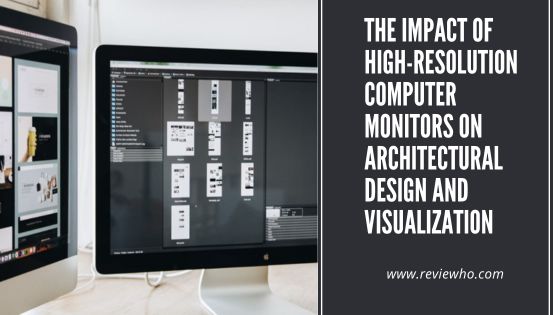In today’s digital age, architects and designers face many challenges in creating designs that meet the requirements of clients and regulators. They need to produce designs that are aesthetically pleasing, structurally sound, and functional. Architects and designers rely heavily on computer technology and software to meet these demands to create their designs.
However, the use of low-resolution computer monitors has often limited the ability of architects and designers to produce high-quality designs. The good news is that high-resolution monitors have changed the game in architectural design and visualization, making it possible to create more detailed and accurate designs.
Understanding High-Resolution Monitors
To fully appreciate the impact of high-resolution monitors on architectural design and visualization, it’s essential to understand what they are and how they work.
What Are High-Resolution Monitors?
High-resolution monitors are computer monitors that display images and designs at a much higher resolution than traditional monitors. They can display more details and colors, making them ideal for architects and designers creating highly detailed designs.
How Does High-Resolution Monitor Work?
High-resolution monitors work by using more pixels than traditional monitors. Pixels are the tiny dots that make up the images and designs displayed on a monitor. The more pixels a monitor has, the more detailed and accurate the images and designs will be.
Traditional monitors typically have a 1920 x 1080 pixels resolution, while high-resolution monitors can have resolutions of up to 3840 x 2160 pixels or even higher. High-resolution monitors display four times more detail than traditional monitors. You can purchase from Jlink at a reasonable price, visit the store.
Types of High-Resolution Monitors
There are several types of high-resolution monitors available on the market today. The most common styles include:
4K Monitors: 4K monitors have a resolution of 3840 x 2160 pixels, four times that of traditional 1080p monitors.
5K Monitors: 5K monitors have a resolution of 5120 x 2880 pixels, five times that of traditional 1080p monitors.
Ultrawide Monitors: Ultrawide monitors have a wider aspect ratio than traditional monitors, allowing for more screen space and higher resolutions.
OLED Monitors: OLED monitors use organic light-emitting diodes to create vibrant, accurate colors and deep blacks, making them ideal for design work.
Choosing the Right High-Resolution Monitor for Architectural Design and Visualization
Choosing the right high-resolution monitor for architectural design and visualization depends on several factors, including budget, screen size, and resolution. Architects and designers should consider the following when choosing a high-resolution monitor:
Screen Size: Larger screens are better for architectural design and visualization, providing more screen space for displaying designs and visualizations.
Resolution: Higher resolutions are better for displaying more details and colors in designs and visualizations.
Budget: High-resolution monitors can be expensive, so it’s important to consider the budget when choosing a monitor.
How High-Resolution Monitors Changed Architectural Design and Visualization
Before high-resolution monitors, architects and designers had to rely on low-resolution monitors, which could not accurately display the details of designs. These monitors would often distort the design, making it difficult for architects and designers to make the necessary adjustments. It led to many designs being rejected by clients and regulators due to their inability to visualize them accurately. On the other hand, high-resolution monitors have revolutionized the architectural design and visualization process by allowing architects and designers to see every detail of their designs in real-time.
The Benefits of High-Resolution Monitors in Architecture
High-resolution monitors have brought many benefits to the field of architecture and design. One of the most significant benefits is the ability to display more details of designs. With high-resolution monitors, architects and designers can now see the details of their designs in real-time, allowing them to make adjustments as necessary. It has significantly reduced the number of revisions required in the design process, making it more efficient and cost-effective.
Another significant benefit of high-resolution monitors is their ability to display colors accurately. Color is an essential aspect of architectural design, and accurate color representation is crucial for architects and designers to create designs that meet their client’s expectations.
High-resolution monitors allow for accurate color representation, ensuring that architects and designers can produce designs that accurately reflect their clients’ preferences.
The Drawbacks of Using Low-Resolution Monitors in Architecture
Using low-resolution monitors in architecture had several drawbacks that impacted the design process. One of the most significant drawbacks was the inability to display details accurately. Low-resolution monitors often distort the facts of designs, making it difficult for architects and designers to see the full picture. It led to designs being rejected by clients and regulators due to their inability to visualize them accurately.
Another drawback of using low-resolution monitors was the inaccurate representation of colors. Low-resolution monitors would often display colors incorrectly, making it challenging for architects and designers to create designs that met their client’s expectations.
The Impact of High-Resolution Monitors on the Architectural Design Process
High-resolution monitors have significantly impacted the architectural design process by making it more efficient and cost-effective. With high-resolution monitors, architects and designers can see every detail of their designs in real-time, reducing the number of revisions required in the design process. It has led to faster turnaround times and reduced costs for clients.
Another significant impact of high-resolution monitors on the design process is the ability to work remotely. High-resolution monitors allow architects and designers to work from anywhere, allowing them to work on projects without being physically present in the office.
The Impact of High-Resolution Monitors on Architectural Visualization
Architectural visualization is a critical aspect of the design process, allowing architects and designers to communicate their designs to clients and regulators. High-resolution monitors have revolutionized architectural visualization by allowing architects and designers to create more detailed and accurate visualizations. It has led to better communication with clients and regulators, reducing the revisions required in the design process.
The Future of Architectural Design and Visualization with High-Resolution Monitors
High-resolution monitors have already significantly impacted architectural design and visualization, but the future looks even brighter. We expect to see even higher resolutions and more advanced features in high-resolution monitors as technology improves.
One of the most exciting developments in high-resolution monitors is integrating virtual reality (VR) and augmented reality (AR) technology. This technology allows architects and designers to create immersive 3D environments that can be explored in real-time, providing clients and regulators with a more realistic view of the design.
Another development is high-dynamic-range (HDR) technology, which allows for more vibrant and accurate colors in designs and visualizations. HDR technology is already available in high-resolution monitors and is expected to become more common.
Conclusion
High-resolution monitors have significantly impacted architectural design and visualization, allowing architects and designers to create more detailed and accurate designs while making it easier to communicate those designs to clients and regulators. With the continued development of technology, we can expect to see even higher resolutions and more advanced features in high-resolution monitors, making them an indispensable tool for architects and designers in the future.







